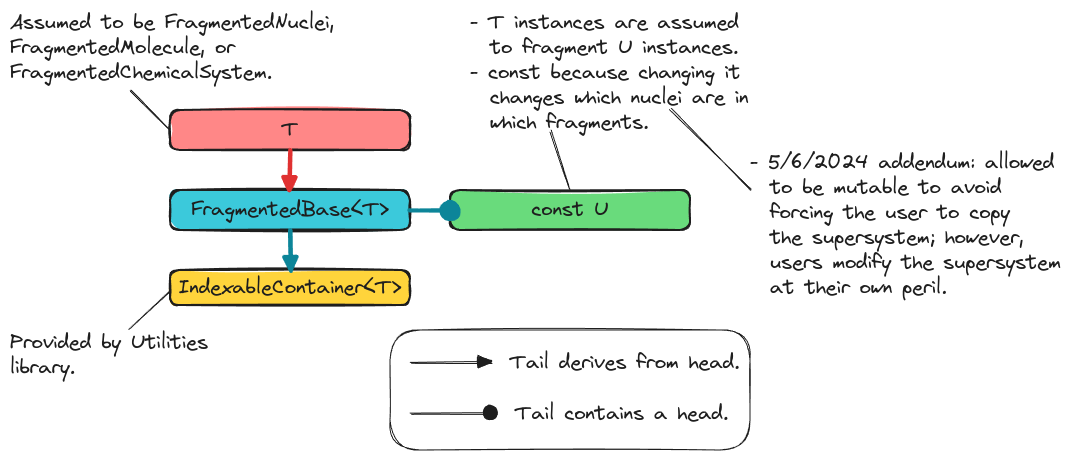Designing the FragmentedBase Class
This page describes the design of the FragmentedBase<T> class template.
Why Do We Need a FragmentedBase Class?
As motivated in Designing the Fragmenting Component, the
FragmentedBase<T> class template is introduced to factor shared
functionality from FragmentedNuclei, FragmentedMolecule, and
FragmentedChemicalSystem.
FragmentedBase Considerations
- container
All
FragmentedBase<T>objects should satisfy the concept of
- supersystem
FragmentedNuclei,FragmentedMolecule, etc. have in common that they contain subsets of a superset. TheFragmentedBase<T>factors out the infrastructure for holding the superset and interacting with it.Addendum 5/9/2024. Factoring out the supersystem leads to extra copies when
FragmentedMoleculeis implemented in terms ofFragmentedNuclei. This is because the bases of bothFragmentedNucleiandFragmentedMoleculeassume they own the supersystem. Accessing the supersystem is still done through the base, but we instead opted for a virtual function to retrieve it from the derived class (this allowsFragmentedNucleito own theNucleipiece andFragmentedMoleculeto own the charge/multiplicity piece).
- immutable superset
For the purposes of the super-/sub-set relation we assume that the superset has been fully initialized and will not change.
If the superset changes it will invalidate the elements of the entire class hierarchy, which is difficult to recover from.
5/6/2024 addendum. This consideration has been relaxed. Since the
FragmentedBase<T>object will own the supersystem it is fragmenting it is conceivable that the user may want to update that supersystem directly rather than needing to copy it out, modify it, and then create a newFragmentedBase<T>(actually aT) object with the new supersystem. This still has the potential to invalidate the class hierarchy, but if the user knows what they’re doing it can still be okay…
- null and empty states
The state of
FragmentedBase<T>is defined in reference to a supersystem. This raises a conundrum, how can we tell aFragmentedBase<T>with no supersystem (and also no fragments) from one with a supersystem, but no fragments? We opt for distinguishing between null and empty. Null meaning there is no supersystem and empty meaning there is a supersystem, but no fragments.Addendum 5/9/2024. The empty set is a universal constant and have opted for null objects to instead fragment the empty set. An object with a non- empty superset, but no fragments can be distinguished by comparing the supersets.
FragmentedBase Design

Fig. 9 Classes related to the implementation of the FragmentedBase<T> class.
Fig. 9 shows the classes involved in implementing
FragmentedBase<T>. To satisfy container, FragmentedBase<T>
inherits from utilities::IndexableContainer<T> class. In accordance with
supersystem, FragmentedBase<T> contains an object of type U
such that U is the class from the chemical system component T fragments.
Summary
- container
FragmentedBase<T>inherits fromutilities::IndexableContainer<T>to satisfy this consideration.- supersystem
FragmentedBase<T>manages a supersystem object.- immutable superset
Addressed by storing the superset as a read-only object.
- null and empty states
The default constructor will fragment an empty set object, whereas the constructor which takes a superset creates an empty object.